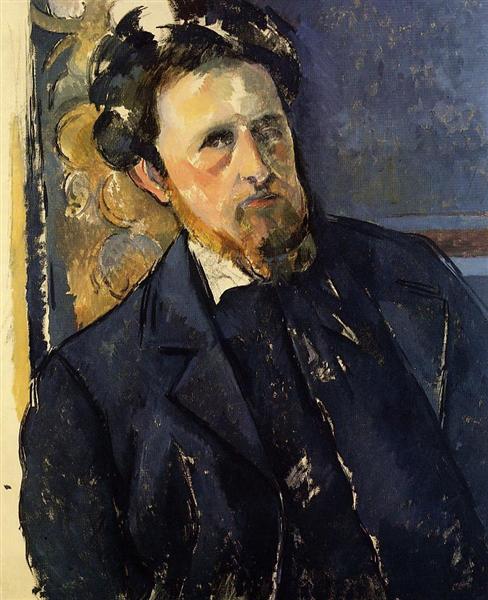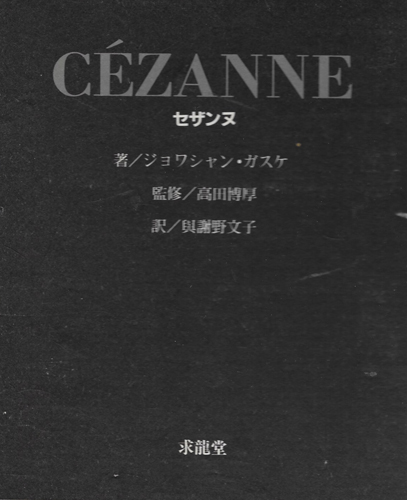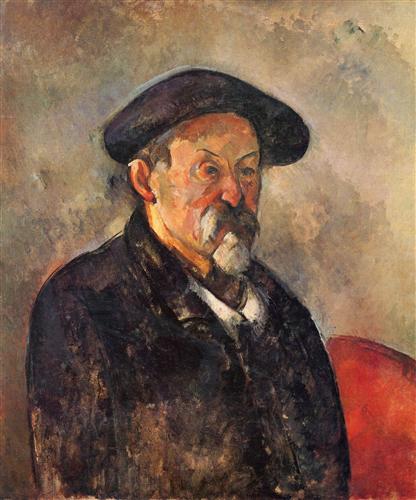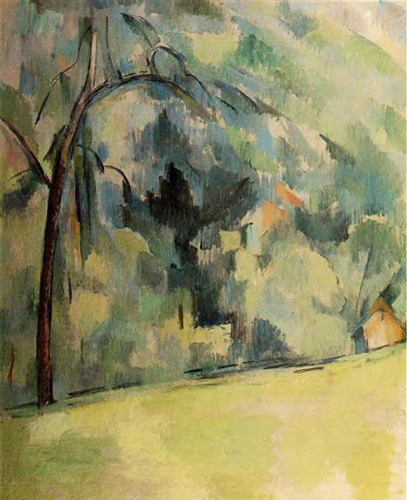Cézanne: Mistral of Aix-en-Provence, Part Three
Yuko Otomo
March 2018
 Portrait of Joachim, 1896
Portrait of Joachim, 1896
7. Books
The explosion of my consciousness facing Cézanne, his country, his atelier & his mountain as the actual physical reality was so intense & overpowering that it took almost 2 months to gather my scattered, mostly fragmental abstract thoughts back into my mind to describe them in words. It was like waiting for the post-explosion dust to settle down on the ground. In the meantime, I re-read some books on Cézanne I had in my possession. One book has a very personal memory & attachment to it. It is a Japanese translation of “Cézanne” by Joaquim Gasquet published by Kuryu-Do press in 1970. Another is “Cézanne in perspective” (edited by Judith Wechler, Printice-Hall 1975), a collection of writing on Cézanne by critics & artists including Zola, Pissarro, Gauguin, Emil Bernard, Maurice Denis, Ambroise Vollard, Rilke, Mattise, Kandinsky, Gleizes & Metzinger, Leger, Gris, Picasso, Clive Bell, Roger Fry, D. H. Lawrence, Merleau-Ponty, Clemente Greenberg, Meyer Shapiro & more, spanning the period from 1874 – 1963.
The original French version of Joaquim Gasquet’s “Cézanne” was published in 1921, 15 years after Cézanne’s death & just before Gasquet’s own death. The translation of my Japanese edition was done by Yosano Fumiko, a French scholar, translator & poet, grandchild of a historically important Japanese couple, the poets Yosano Tekkan & Yosano Akiko, who together opened the door of Modern Japanese Poetry thorough their “Myojo” periodicals. Their contribution to the history of Japanese poetry is a major event that influenced its development in such a profound level.
The book is accompanied by an intimate introductory essay by an artist Takada Hiroatsu who read the original French version when it came out more than half a century before the publication of the Japanese translation. He mentioned that then there were no “real” Cézannes, but only the reproductions of his work in Japan. He later lived in France, mostly in Paris, but also in Aix-en-Provence. He knew Picasso & other artists of the time closely. He talks of the episode of visiting Picasso in rue de La Boétie, Paris & seeing a large painting of Cézanne’s Mt. Sainte Victoire in the main room. Picasso said to Takada that he loved the painting so much that he traded it with 25 of his own paintings through some dealer. Takada also talks of visiting Matisse in his Montparnasse apt. & seeing a small Cézanne still life with 2 apples. Matisse persuaded him to get closer to it, saying, “ Come & see… this is Cézanne…” as they finished greeting each other. He also talks of seeing Cézanne paintings in Signac’s collection. He also talks of Romain Rolland telling him of Cézanne’s strength of submitting works to the official salon year after year, although he was never accepted. He told Takada to do the same, not to fall into despair for being rejected. Interestingly, the English translation version took much longer to come out in print in 1990 (Thames & Hudson) first as the hard cover & then as the soft cover in 1991.
My Cézanne book is a beautiful hard cover book with the slipcase. It has a few fine reproductions of Cézanne’s works, some in color & some in black & white. His self-portrait (o/c 1879-82), Artist’s father (o/c 1866), Achille Emperaire (o/c 1866), Plaster stature of Cupid (o/c 1895), Grand Bathers (o/c 1898-1905), Mt. Saint Victoire (o/c 1886-88), Card Players (o/c 1890-92) & a portrait of Joaquim Gasquet (o/c 1896-97) himself. Sometime in the 80s, when I went back home visiting my family in Japan, my father handed me the copy & said, “This is for you. It was waiting for me to pick it up in my favorite used bookstore in Karatsu (*his hometown) to give it to you! It is going to be an important book for you.” Since then I read the book at least 2 – 3 times being totally fascinated by it. The symbolic & emotional attachment to this book comes naturally from my personal relationship with my father (who was my Haiku teacher; now long gone) & another, the creative one with Cézanne.
I read this book from the beginning to the end again as I settled down to the city life being back home from the trip in the late fall. Miraculously & finally, I understood every word of the book. It is not that I did not understood what was written before, but, this time, every word made complete sense to me in depth. Especially, the part two of the book “What he told me” with 3 sections: 1. Motif; 2. The Louvre; 3. Atelier gave me a chance to delve into his art & philosophy further. When he talks of the mountain, I see it in my eyes physically since I had an actual physical contact with it. When he talks of the light/shadow, I see it not as words, but I see them as the reality. For me, being in Aix physically was totally crucial to understand Cézanne’s words. Of course, they were written in the time there was no recording devices, so, I have to assume Gasquet’s dictation of Cézanne’s words were as accurate as possible.

8. What He Told Me
The below is some of what the artist said in part two of the book that caught my attention. How fascinating it is to read his words, words of Cézanne who was a passionate poet in Latin when he was young! I translated the Japanese text at randomly according to the order I found them. There could be some unavoidable discrepancy in the content since it was translated first from the French to the Japanese & then again from the Japanese to the English.
Motif:
all the will of an artist must be silent. you have to quiet down the voice of prejudice, you have to forget & forget & soak yourself in silence, then you become a perfect echo… when the sensation reaches its peak, it unites with the whole existence in harmony…
what I try to say is more mysterious & it is tangled up with the roots/origin of existence & the source of sensation that you can not catch with your hand. that’s what constitutes temperament, I think… the sun… listen to me…who will paint or speak of the serendipity of light, the movement of the sun, its observance & its transformation? it is the physiology of the earth, its psychology… every living creature, everything after all, is a stored & systematized tiny amount of the solar heat, something like a memory of the sun…
I want to abstract that essence…
the place where our brain & the universe touch each other is in color… look at that Mt. Saint Victoire, that mass of rock used to be a fire. it still carries fire inside… that’s why great painters’ color are filled with the drama…
in order to paint a landscape, you must find its geological foundation… think about it… the history of the world began with the meeting of two atoms, two alchemical whirl winds, two dances got together… as I read Lucretius, I see them coming out & being harmonized to be full… in this misty rain, I breathe in the virginity of the world…
I am a primitive in my own path. I want to reach to a formula with my awkward belief…
like someone said, I imagine that a small amount of study will keep you away & a massive study will pull you back… yes, a lot of study will bring you back to nature since you’ll know it is not enough to have métier alone…
when I paint, I don’t think… I see colors… I enjoy carrying the color on canvas as I see them…they decide where to go themselves…
as you have not painted gray, you can not be called a painter…
nature is talking to everybody. yet, landscape has never been painted… non-existing human at the same time totally involved in landscape… restfulness without an allegory, color! here, I just pile it up & let myself bloom as it is… this earth is pregnant… I smell its smell, even being far away, even in Paris…
in order to express everything, to place it in the right place, there is only one way. color… color is a living creature… living alive, color gives life to a matter…
to treat nature with the cylinder, the sphere, the cone… the scene Pater Omnipotens Aetern opens in front of your eyes… nature, to us human, exist not on the surface, but in depth… that’s why in order to feel the air inside of the vibration of light realized by various red & yellow, there comes a need to add various sky-colors…
Monet is an eye… an extremely unique eye since the history of artists started… I take my hat off for him… he (Pissaro) used to tell me to paint only with 3 primal colors & their combinations… but nothing else… yes, right, he was the first Impressionist. what is Impressionism? it’s a mixture of visual cognitions of color…
I trembled when I found it out… if I can manage to let others experience this trembling sensation I feel through the mysteries of color, they too might be able to have a richer & more joyful sense of what the universe is…
I want to paint time & space as an appearance of color sensation…
color is the life of the world; the life of every idea… that’s why you should not color from dessin… the maturity of color always corresponds with the maturity of dessin… nature abhors straight lines… yes, sensation is there for everything as the foundation…
we are all the same one human… positivism of the landscape… an obsession of the universe that envelops us… listen to me…
The Louvre:
I call myself a classicist… I wish I was one… yet it is boring…
it is much easier to express god using a cross than to express it with an expression of a face…
there were no separation between matter, living things & color… no dessin; no abstraction, everything is created by color…
museums are Plato’s cave, I will chisel the sign that says “painters not permitted. the sun is in the outside.”… painters nowadays start painting when they reach 40… when there were no such things as museums, their life-time works were done by they reached 40… today’s painters know nothing… you should go to museums till you become 40, I command… after that, even when you go back to such a graveyard, you can just relax contemplating on your inability & your own death… museums are things to hate… it smells of democracy & middle schools…
after all, the foundation, the secret soul of the foundation, becoming the connecting tissues, giving the strength & the lightness to the whole… you should always start with a light gray…
instead of theoretically accurate, I want to be accurate in realization…
you should never be corrupt in your art… in order not to be corrupt in your art, you have to train to do so in your life as well…
as far as you know what has to be done, things will be known eventually…
Atelier:
“study/etude” changes our visual senses… I always carry things very slowly…
there are things I have been working on over 35 years… there are 3 things that consist the foundation of métier…honesty, sincerity, obedience/submissiveness…
whenever I stand in front of an easel, I become the other… at the same time it is the same Cézanne…
I swear to myself to die painting…
I only like working…
prism, it’s the first way for us to know god… it is our beatitude… pure geology of eternal grand heaven…area that is filled with god’s diamond…
drawing & color are not separated…when color peaks its richness, form reaches to the highest… the rest is poesy, it comes to its own being naturally…
a painter has two things, eyes & the brain… they should support each other… you should work positively to aim for their mutual development…
after all, light does not exist for a painter…
as soon as we become painters, we swim in the middle of water, in the middle of color, in the middle of reality…
our paintings, they are like a night that blindly moves on…a night that roams around night after night…
ah… to have a student! to hand over all my experiences to someone. I am nothing. I have not accomplished anything, but I’ve learned things. to hand it to someone… uselessly… could be useless…
a thing has its own métier… you can never successfully learn your own métier… even if I paint 100 years or 1000 years non-stop, I’ll know nothing… but that’s life… I want to die painting…
what I can not finish, somebody else will… perhaps, I might be a primitive of one new art…
I want to die painting… I will die painting…
 Self-Portrait with Beret, 1900
Self-Portrait with Beret, 1900
9. Why Cézanne needed to stay in Aix-en-Province
Standing on the rooftop of the apt. in the 18th century building in the old section of Aix: Centre-Ville where we had a salon concert as part of the festival in the evening of Oct. 15, I saw a sunset & birds (“Etourneux”: Returning) circling in mass. The image made me thing of Neitzsche’s Eternal Return. How fascinating it was that the day was his 173rd birthday coincidentally! Soon, the sky darkened, birds gone & then a big dipper appeared in the endless sky. As I breathed in the clearest night air I ever had breathed in my life, I understood why Cézanne needed to go home to Aix: the place he was born & grew up to stay there, leaving Paris the art & cultural capital of Europe. Not because of the nostalgia, not because of his personal awkwardness of not fitting into the Paris society, but for the LIGHT & geology of the region: the essential foundation needed for his intense search in color & form. Aix has one of the clearest air & LIGHT you can ever imagine. This clarity has nothing to do with dryness or brightness. It has something to do with the molecule-level incredible physical transparency that this particular part of the earth’s geography provides. Because of the translucency of LIGHT, nothing is filtered. Everything projects itself totally directly as it is.
Cézanne was born with the unique sensitivity & temperament to feel & register the degree of clarity of air & LIGHT in the maximum intensity & depth. The secret of his superb ability of “seeing” is born out of the marriage between Aix’s air & LIGHT & his extra ordinarily sensitively personal sensory cognitive attributes he was born with. What a miraculous matchmaking it was that “he” was born in “Aix”! Compared to Aix, Paris is a grey & muted city with moisture & defused light. Things get muted, filtered & indirect. He needed a direct contact with what he saw to further his quest. Once I was aware of “what LIGHT means,” being in Aix & bathed in its LIGHT, I actually learned to observe how the gradual mutation of light took place. I finally saw how it shifted, leaving Aix to Marseille & then from Marseille back to Paris. It was an amazing physical experience to observe a graduation of LIGHT as if it were some kind of a scientific experimentation.
Cézanne’s self-conviction was unmovable, unstoppable & sound no matter how much he struggled over every effort to achieve what he believed in. It was not his “doubt” that propelled him to move on but his faith & belief. He did not doubt that he was right. He knew that he was right. But he also knew that knowing was not enough but the actual realization of what he knew & what he saw was crucial. That was why he kept on going & kept on struggling without an end. He died painting as he wished, muttering, “What I can not finish, somebody else will…” So identical to what Rimbaud said in his “seer’s letter”: “There will come other horrible workers; they will begin where he has succumbed…” He stopped breathing, wishing that someone after him would pick up what he had left to continue the journey/quest.
Cézanne is a father to us all who are involved in the art of painting. Myself included. He did die painting as he wished. He died in 1906 when both Cubism & Fauvism started to break through into the history of art. Yes, art is long; life is short. The honesty & sincerity of Cézanne’s devotion consequently opened the door for new art for us all. Even for me. He definitely planted the seed for the future. He swept us all out of the old & brought us to the new: the 20th Century Modernism. Yes, we are all his children, grandchildren, and great-grand children. His honesty & sincerity toward what art is & what an artist can & should do/be will always be the most accurate mirror we can hold to reflect ourselves upon.
Apples, objects, humans or landscapes big & small, they all were his 心 (Kokoro – heart/mind/soul/spirit): his cosmic universal truth.
 Morning in Provence, 1906
Morning in Provence, 1906
Link to Cézanne: Mistral of Aix-en-Provence, Part Two
Cézanne: Mistral of Aix-en-Provence, Part One
______________________________________________________________________________________________
Yuko Otomo is a visual artist & a bilingual poet/writer of Japanese origin. Her publications include Garden: Selected Haiku (Beehive Press), Genesis (Sisyphus Press), Small Poems (Ugly Duckling Presse), The Hand of The Poet (UDP), STUDY & Other Poems on Art (UDP), Elements (Feral Press), KOAN (New Feral Press) & FROZEN HEATWAVE: a poetry collaboration project with Steve Dalachinksy (Luna Bison Prods).
To read more by Yuko Otomo, click here
